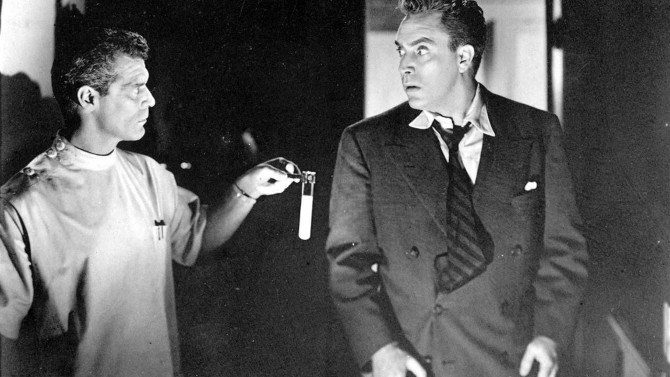Talk about a hook of an opener – an extended tracking shot follows a man from behind as he enters a police station to report a murder. . . his own, and, rather interestingly, it seems as though the detectives were waiting for him.
The man – Frank Bigelow (Edmond O’Brien); the film noir, D.O.A., a 1949 mystery directed by Rudolph Maté (a man who made several quality movies, though is better known for his superlative work as a cinematographer – think of Carl Theodor Dreyer’s two silent masterpieces The Passion of Joan of Arc and Vampyr, or later, Alfred Hitchcock’s Foreign Correspondent, Ernst Lubitsch’s To Be or Not to Be and Charles Vidor’s Gilda). Bigelow narrates his story to the men, transporting us back to the beginning of the tale.
An everyman, Bigelow is a small time business owner, an accountant and notary public, who is looking to get away. His confidential secretary, and perhaps more importantly, girlfriend, Paula Gibson (Pamela Britton) is head over heels in love with him, though her clingy ways are making the man feel a tad claustrophobic.
Taking a one week vacation to San Francisco on the spur of the moment, he is most definitely not opposed to observing the fairer sex in what could be termed a ‘wandering eye’. With the city playing host to a raucous group of salespeople attending a convention, Bigelow heads out on the town with a group of them, specifically to a jive club.
It is here that things take a turn when the man’s drink is swapped, and he ingests poison. With less than a week to live, he is behind the eight ball, trying to find one flimsy clue after another, willed with a drive that can only come from a person with so little time left. Will Bigelow be able to unravel the complex case that will soon be called murder, or will he die buried under a pile of unanswered questions?
Much like an adrenaline packed episode of 24, D.O.A. moves along at a frantic pace, packed with gunfire, murder, poisoning and mystery, all of which is jammed into a tight, taut one hour, twenty-three minute runtime. As Bigelow manoeuvres through the streets of San Francisco and Los Angeles, he bumps into a number of unreadable individuals, from femme fatales like model Marla Rakubian (Laurette Luez), frequent club-goer Jeannie (Virginia Lee), secretive secretary Miss Foster (Beverly Garland), and a widow named Mrs. Phillips (Lynn Baggett) – whose husband somehow ties into the complex caper, to the widower’s suspiciously knowledgeable brother-in-law Stanley (Henry Hart), the dead man’s agitated former partner Halliday (William Ching), a soft spoken crime boss going by the name of Majak (Luther Adler), and psychopathic tough guy Chester (Neville Brand), each and every individual is a possible suspect when it comes to discovering whodunit?
Featuring some interesting visuals, perhaps one of the more memorable moments finds the tortured Bigelow struggling to cope following the reveal that he has been poisoned – leaning against a newsstand that is chock full of Life magazines, he is teased by the world, having to grab a ball for a jaunty young girl and then seeing the embrace of a clearly in-love couple, all of the things he will never be able to have – the irony of it all. In the end, the whole plot revolves around this concept of irony, after all, it is his impending death that brings forth in him a drive and power that he has never experienced before, a chance for him to achieve something noteworthy, alas only by hunting down his own murderer.
For film buffs, a truly fascinating aspect of D.O.A. is that a portion of it was made in front of the Million Dollar Theater (owned by the movie’s producer Harry Popkin) as well as the famed location across the street, the Bradbury Building (the climax is shot inside). Though it may not immediately ring a bell, both of these locales feature prominently in another classic, 1982’s Blade Runner, though forty-three years later. It will be instantly recognizable to anyone who is a fan of Ridley Scott’s dark futuristic vision, and adds just as much visual flair to the moments found in this film noir. Another little tidbit that must be mentioned is that there is a sequence that finds Bigelow running frantically through the streets. . . a stolen shot, the crew did not have permits to shoot on Market Street in San Francisco, so the mystified reactions of those who O’Brien pushes through are wholly real. Finally, for those fans of hidden Easter eggs (an inside joke in the media world), as Bigelow signs in at the Allison Hotel in L.A., the names Russell Rouse, Ernest Laszlo, and Marty Moss can also be seen: the writer, cinematographer and assistant director on the project.
With an ahead of its time plot, D.O.A. is a must watch for film fans. Entertaining and engaging, fun as well as dark, the only thing that seems a bit off is the score by Dimitri Tiomkin (whose work I generally am a big fan of) – it is too over the top and melodramatic for the most part, and goes for bizarre comedy (with a slide whistle no less) every time Bigelow checks out one of the sultry dames. . . though the jazzy elements infused within it (especially in the night club) are outstanding – meaning it is not a total writeoff. So, make sure to check out this film noir, you won’t feel D.O.A. when you make your way to the finish.


